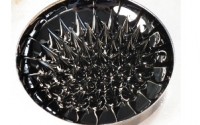The Magic Of Magnetic Liquids
- Date
- 8 Jan 2012
- Start time
- 2:30 PM
- Venue
- Tempest Anderson Hall
- Speaker
- Prof Kevin O'Grady & Mr Ian Helliwell

The Magic of Magnetic Liquids
The Christmas Family Lecture, joint event with York Museums Trust
Professor Kevin O’Grady & Ian Helliwell, Department of Physics, University of York
Everybody knows that there are no magnetic liquids. Liquid mercury is a metal but it is not magnetic. This lecture seeks to explain why this is the case and to show how liquids can be made magnetic and what happens to them when they are. This leads to some very strange effects due to the fact that a normal liquid is only subject to the force of gravity and therefore has a flat surface. When a magnetic liquid is exposed to a magnetic field the surface no longer stays flat as shown in the photograph. Even stranger effects are observed when a magnetic liquid is in contact with another liquid and a magnetic field is applied.
The environment within a world where the material is magnetic is very different to that in our environment where materials are not magnetic. For example, in the magnetic world a non-magnetic material can be fooled into thinking it is magnetic. All these effects will be demonstrated in the lecture.
More seriously magnetic liquids have applications. You can use a magnetic field to move a magnetic liquid or to hold it fixed in one place. This leads to applications in vacuum seals but also in devices such as loudspeakers. Almost all people have some magnetic liquid in their house and in their car. Special mixed magnetic liquids can be made that will change from a liquid to a solid when a magnetic field is applied. This enables us to make controlled dampers and clutches which are now quite common in luxury cars. During the lecture you can stand on a magnetic liquid.
The lecture is hands-on and many experiments are passed around the audience and at the conclusion you are invited to come and play with my magnetic liquid toys.
Report
by Tom Hartle
An eagerly anticipated lecture, with a promised hands-on approach, delivered to a packed audience including many children. Heading a company which manufactures magnetic liquids, Professor Kevin OGrady could deliver a commercial, as well as scientific view of these extraordinary materials. Although there are no true magnetic liquids, ferrofluids can replicate their properties by using a colloid of nanosized particles of a ferromagnetic solid, for example iron oxide, suspended in a solvent. Surface instability was demonstrated, where the fluid deforms to keep its surface perpendicular to the diverging lines of force of an applied magnetic field. This results in a bizarre hedgehog-like surface.
Professor OGrady also demonstrated liquids which solidified in a magnetic field, passing around a syringe of fluid, which became fixed near a magnet. He went on to describe some practical uses, including vacuum seals and dampeners for car loudspeakers. Non-magnetic particles also become magnetic when suspended in ferrofluids, as was demonstrated by rows of dancing polystyrene balls. There are even biomedical applications, where the heating effect which results from a rapidly changing field could be used to destroy certain cancers.
Sponsored by York Museums Trust